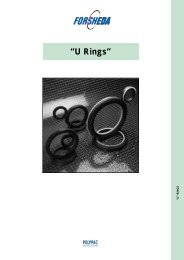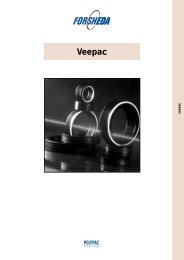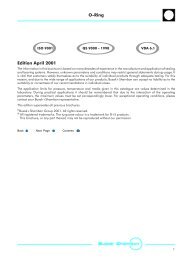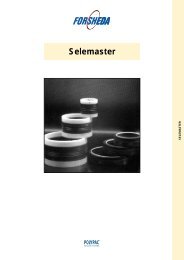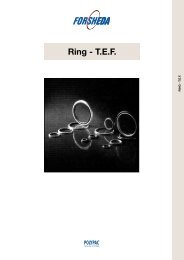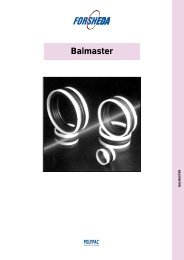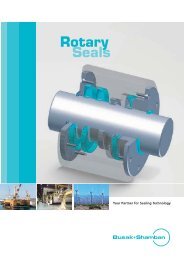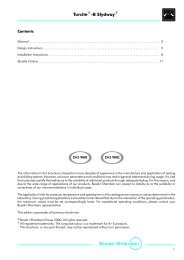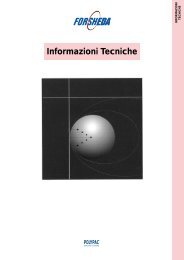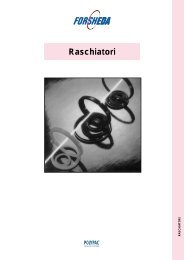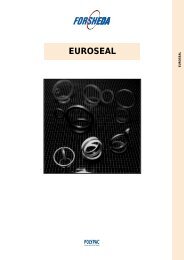LuytexR - Composite Materials - Dilanda.it
LuytexR - Composite Materials - Dilanda.it
LuytexR - Composite Materials - Dilanda.it
Create successful ePaper yourself
Turn your PDF publications into a flip-book with our unique Google optimized e-Paper software.
Luytex R - <strong>Compos<strong>it</strong>e</strong> <strong>Materials</strong><br />
Contents<br />
General Introduction ........................................................................ 3<br />
Applications ................................................................................ 4<br />
Qual<strong>it</strong>y Cr<strong>it</strong>eria ............................................................................. 4<br />
Selection Cr<strong>it</strong>eria ........................................................................... 5<br />
Material Properties .......................................................................... 6<br />
Installation Possibil<strong>it</strong>ies ....................................................................... 9<br />
Machining Instructions ....................................................................... 10<br />
Raw <strong>Materials</strong> - Luytex R C361 on Stock ........................................................ 11<br />
Standard Plain Bearings ..................................................................... 12<br />
Installation Recommendations .............................................................. 12<br />
Design Guide for Non Standard Products ....................................................... 14<br />
Installation Recommendations .............................................................. 16<br />
Slydring R .................................................................................. 18<br />
Installation Recommendations .............................................................. 19<br />
Marine Applications ......................................................................... 20<br />
Safety Data Sheet ........................................................................... 21<br />
Storage ................................................................................... 21<br />
*KI= 5D=>=<br />
1
Luytex R - <strong>Compos<strong>it</strong>e</strong> <strong>Materials</strong><br />
ISO 9001 ISO 9002<br />
The information in this brochure is based on many decades of experience in the manufacture and application of sealing<br />
and bearing systems. However, unknown parameters and cond<strong>it</strong>ions may restrict general statements during usage. It is<br />
v<strong>it</strong>al that customers satisfy themselves as to the su<strong>it</strong>abil<strong>it</strong>y of individual products through adequate testing. For this reason,<br />
and due to the wide range of applications of our products, Busak+Shamban can accept no liabil<strong>it</strong>y as to the su<strong>it</strong>abil<strong>it</strong>y or<br />
correctness of our recommendations in individual cases.<br />
The application lim<strong>it</strong>s for pressure, temperature and speed given in this catalogue are maximum values determined in the<br />
laboratory. During practical applications <strong>it</strong> should be remembered that due to the interaction of the operating parameters,<br />
the maximum values must be set correspondingly lower. For exceptional operating cond<strong>it</strong>ions, please contact your<br />
Busak+Shamban representative.<br />
This ed<strong>it</strong>ion supersedes all previous brochures.<br />
e Busak+Shamban 2000. All rights reserved.<br />
R All registered trademarks. The turquoise colour is a trademark for B+S products.<br />
This brochure, or any part thereof, may not be reproduced w<strong>it</strong>hout our permission.<br />
2<br />
*KI= 5D=>=
Luytex R - <strong>Compos<strong>it</strong>e</strong> <strong>Materials</strong><br />
General Introduction<br />
Description<br />
Luytex R materials are compos<strong>it</strong>es of fine weave fabrics<br />
impregnated w<strong>it</strong>h special thermosetting polyester resins.<br />
In order to improve their mechanical properties - in<br />
particular the friction coefficient - special add<strong>it</strong>ives can be<br />
incorporated in the resin.<br />
Luytex R materials are su<strong>it</strong>able for widely differing<br />
applications due to their wide range of mechanical and<br />
physical properties.<br />
Design<br />
Structural elements such as bushings, drums, slide plates,<br />
rollers, etc. are supplied ready for installation according<br />
to the customer’s drawings or to our own designs.<br />
Luytex R materials are also available as semi-finished<br />
products in the form of :<br />
- Tubes<br />
- Rods<br />
- Sheets<br />
- Discs<br />
Characteristics<br />
Due to their high load bearing capabil<strong>it</strong>y and good sliding<br />
properties, Luytex R materials can be in many cases used<br />
as bearing materials for metallic parts. By manufacturing<br />
w<strong>it</strong>h add<strong>it</strong>ional lubricants, the sliding properties can be<br />
further enhanced, particularly for dry running applications.<br />
The high permissible specific surface pressures also<br />
provide long service life.<br />
Low specific weight allows dimensionally stable light weight<br />
machine parts to be produced.<br />
This can be a particularly important factor w<strong>it</strong>h large<br />
diameters where a similar part in bronze would be five<br />
times heavier.<br />
Advantages<br />
From the point of view of <strong>it</strong>s price / performance ratio,<br />
Luytex R represents an effective alternative to the<br />
conventional metallic bearing materials. The use of these<br />
materials provides effective solutions to a large number of<br />
applications.<br />
Main advantages:<br />
- High load bearing capac<strong>it</strong>y<br />
- Generally less wear than metallic bearing materials<br />
- Lower coefficients of friction<br />
- Damping of mechanical vibrations<br />
- Easy to machine and install<br />
- Swell in water < 0,1 %<br />
- Long service life<br />
- Savings in weight w<strong>it</strong>h large components reduce freight<br />
charges<br />
- Ideal for use in fresh or salt water<br />
- Good chemical resistance<br />
- Eliminates local stress concentrations, edge loading, etc.<br />
- Metal / plastic pairing eliminates fretting<br />
- Contains no environmentally hazardous or<br />
toxic substances<br />
*KI= 5D=>=<br />
3
Luytex R - <strong>Compos<strong>it</strong>e</strong> <strong>Materials</strong><br />
Applications<br />
Areas of Applications<br />
A few of the potential applications of Luytex R materials<br />
are given below as examples : the choice of su<strong>it</strong>able<br />
materials for particular application can be found in table I<br />
on page 5.<br />
Water-Lubricated Application:<br />
Car washing machines<br />
Spray head bearings<br />
Scale breakers<br />
Paper machine bearings<br />
Grinding machines<br />
Water filtration plants<br />
Nuclear reactors<br />
Sewage work<br />
Lubrication by the Process Fluid:<br />
Textile machines<br />
Pickling plants<br />
Anodizing baths<br />
Pump bearings<br />
Chemical and petrochemical industry<br />
Oil and Grease Lubrication:<br />
Automobile industry<br />
Conveying plants and crane construction<br />
Coal mining<br />
Mining machinery<br />
Press guides<br />
Highly flexible couplings<br />
Construction machines<br />
Dry Running:<br />
Machines for the foodstuffs industry<br />
Electrical industry<br />
Railway locomotive construction<br />
Supporting bearings<br />
Construction machines<br />
Fields of Applications<br />
Due to their good mechanical and physical properties,<br />
Luytex R materials are outstandingly su<strong>it</strong>ed for use as<br />
guides and bearings subject to high loads, e.g.<br />
- As guide rings, in hydraulics applications, guides and<br />
slideways for reciprocating pistons, rods, plungers,<br />
slide and guide rails<br />
- As bearings, thrust washers and bearing shells for<br />
rotating and oscillating drums, shafts, bushings and<br />
spindles<br />
Most commercially available oils and greases w<strong>it</strong>hout<br />
solid add<strong>it</strong>ives (e.g. molybdenum disulphide) can be used<br />
for lubrication. The chemical resistance of Luytex R allows<br />
many process fluids to be used as lubricants. When<br />
material C321, C322, C361, C380 is used, water can be<br />
used as lubricant (swell in water < 0,1%).<br />
The wear of Luytex R materials can be less than that of<br />
conventional metallic bearing materials. Therefore,<br />
depending on the application, longer service life can be<br />
achieved w<strong>it</strong>h a simultaneous improvement in the<br />
properties of the components.<br />
Qual<strong>it</strong>y Cr<strong>it</strong>eria<br />
The cost-effective use of bearings is highly influenced by<br />
the qual<strong>it</strong>y cr<strong>it</strong>eria applied in production. Bearings<br />
manufactured by Busak+Shamban are continuously<br />
mon<strong>it</strong>ored according to strict qual<strong>it</strong>y standards from<br />
material acquis<strong>it</strong>ion through to delivery.<br />
Certification of our production plant in accordance w<strong>it</strong>h<br />
international standard EN ISO 9001 meets the specific<br />
requirements for qual<strong>it</strong>y control and management of<br />
purchasing, production and marketing functions.<br />
Our qual<strong>it</strong>y policy is consistently controlled by strict<br />
procedures and guidelines which are implemented w<strong>it</strong>hin<br />
all strategic areas of the company.<br />
All testing of materials and products is performed in<br />
accordance w<strong>it</strong>h accepted test standards and<br />
specifications.<br />
4<br />
*KI= 5D=>=
Luytex R - <strong>Compos<strong>it</strong>e</strong> <strong>Materials</strong><br />
Selection Cr<strong>it</strong>eria<br />
Table I<br />
<strong>Materials</strong><br />
Material No. Properties Applications Material Colour 1)<br />
C320 High wear resistance<br />
Rod Slydring R in hydraulic<br />
cylinders, guide and bearing<br />
Polyester resin<br />
Polyester fine mesh<br />
grey<br />
(TLG)<br />
bushes, slide pads, etc.<br />
Add<strong>it</strong>ive: graph<strong>it</strong>e<br />
C321<br />
(TL)<br />
C322<br />
(TLM)<br />
C324<br />
(NLD)<br />
C329<br />
(TLF)<br />
C333<br />
(TLP)<br />
C338<br />
(NL25)<br />
C361<br />
(TL60)<br />
C362<br />
(TLC)<br />
C363<br />
(SLG)<br />
C367<br />
(TX)<br />
C380<br />
(TL61)<br />
Orkot R<br />
TLM<br />
Marine<br />
High permissible surface pressure,<br />
vibration damping<br />
High compressive strength,<br />
low swell rate,<br />
resistant to gamma radiation<br />
Low swell rate,<br />
resistant to sea water<br />
High temperature resistance<br />
+ 250C<br />
Bushes, sheets,<br />
parts for insulation, parts w<strong>it</strong>h close<br />
tolerances, food industry grade,<br />
agreed FDA<br />
Sea water applications in<br />
ship-building, marine engineering<br />
and offshore installations<br />
Application at high temperatures<br />
Polyester resin<br />
Polyester fine mesh<br />
Polyester resin<br />
Polyester fine mesh<br />
Add<strong>it</strong>ive: molybdenum<br />
Vinylester resin<br />
Nomex fibre mesh<br />
Fire retardant Mining, plants w<strong>it</strong>h a high fire risk Polyester resin<br />
Polyester fine mesh<br />
Fire retardant add<strong>it</strong>ives<br />
Good sliding properties,<br />
good stick-slip behaviour<br />
High temperature resistance<br />
+ 250_C<br />
Excellent sliding properties<br />
Acid resistant to pH = 3<br />
Good sliding properties<br />
Lower compressive strength<br />
Low friction<br />
High wear resistance<br />
Good sliding properties<br />
Exceptional wear resistance<br />
Low swell rate<br />
Low friction<br />
Highlighted compounds are standard materials.<br />
Moving machine parts w<strong>it</strong>h<br />
low friction<br />
High temperatures<br />
High pv values<br />
Preferred material for non standard<br />
and plain bearings<br />
Chemical plant engineering,<br />
pumps<br />
Pads for guiding<br />
Rotating shafts<br />
Pads<br />
Dry running<br />
Standard material for Slydring R<br />
Rudder bearings, stabilizer bearings<br />
Water lubricated propeller shaft<br />
bearings<br />
Deck machinery bearings<br />
The designations in brackets indicate the replaced designations used in earlier catalogues.<br />
Polyester resin<br />
Polyester fine mesh<br />
Add<strong>it</strong>ive: PTFE<br />
Vinylester resin<br />
Nomex fiber mesh<br />
Add<strong>it</strong>ive: PTFE + MoS2<br />
Polyester resin<br />
Polyester fine mesh<br />
Add<strong>it</strong>ive: PTFE + MoS2<br />
Polyester resin<br />
Polyester fine mesh<br />
Polyester resin<br />
Special polyester<br />
reinforcement<br />
Add<strong>it</strong>ive: graph<strong>it</strong>e<br />
Polyester resin<br />
Polyester fine mesh and<br />
PTFE<br />
Polyester resin<br />
Polyester fine mesh<br />
Add<strong>it</strong>ive: PTFE<br />
Polyester resin<br />
Polyester fine mesh<br />
Add<strong>it</strong>ive: PTFE + MoS2<br />
wh<strong>it</strong>e<br />
grey<br />
milky-wh<strong>it</strong>e<br />
wh<strong>it</strong>e<br />
wh<strong>it</strong>e<br />
grey<br />
blue<br />
wh<strong>it</strong>e<br />
grey<br />
wh<strong>it</strong>e and<br />
black<br />
turquoise*<br />
1) If components of Luytex R materials are used at visible points of machines, construction vehicles, etc. the materials can also be pigmented in certain instances.<br />
* The turquoise colour is a trademark of the B+S Group.<br />
grey<br />
Special grades can be offered to su<strong>it</strong> specific requirements such as improved resistance to alkalis, resistance to acids,<br />
fire retardant add<strong>it</strong>ives, colour pigments for identification, etc. The specialised grades are listed on individual data sheets<br />
which can be supplied on request.<br />
*KI= 5D=>=<br />
5
Luytex R - <strong>Compos<strong>it</strong>e</strong> <strong>Materials</strong><br />
Material Properties<br />
Table II<br />
Mechanical and Physical Properties<br />
Material<br />
properties<br />
C380<br />
C321<br />
Material No.<br />
C361<br />
C320<br />
C367<br />
C324<br />
Tensile strength N/mm 2 55 65 55 60<br />
Compressive strength, static,<br />
N/mm 2<br />
(perpendicularly to the fabric),<br />
fully chambered<br />
Compressive strength, static,<br />
N/mm 2<br />
(parallel to the fabric)<br />
Modulus of elastic<strong>it</strong>y in<br />
tension N/mm 2<br />
BS2782-320E<br />
345 345 345 350<br />
95 92 97 100<br />
3200 3200 3200 4300<br />
Dens<strong>it</strong>y g/cm 3 1,25 1,3 1,25 1,20<br />
Water absorption %
Luytex R - <strong>Compos<strong>it</strong>e</strong> <strong>Materials</strong><br />
Chemical Resistance<br />
Luytex R materials are resistant to many media and<br />
chemicals. Luytex R does not corrode, is resistant to oils<br />
and greases and is not attacked by many solvents,<br />
inorganic solutions and weak acids.<br />
Water or other chemical liquids act as lubricants on Luytex R<br />
materials and reduce friction. Observe the application<br />
recommendations !<br />
Luytex R is not resistant to ketones chlorinated solvents,<br />
strong alkalines and strongly oxidizing chemicals. The<br />
following resistance list is intended only as a guide line.<br />
Where applications involve aggressive media, please<br />
contact the local B+S Organization.<br />
Table V<br />
List of Chemical Resistances<br />
Material No.<br />
C320/C321/C380/C361<br />
Medium +20C +50C<br />
Acetic acid, 15 % A B<br />
Acetic acid, 100 % C C<br />
Acetone, 15 % A B<br />
Acetone, 100 % C C<br />
Ammonia, aqueous C C<br />
Ammonia, carbonated A B<br />
Ammonia, n<strong>it</strong>rous A A<br />
Ammonia water C C<br />
Benzene A B<br />
Bleaching liquors A B<br />
Brake fluid ATE, DOT4 C C<br />
Carbon tetrachloride A A<br />
Chlorinated lime A A<br />
Chlorinated sodium A A<br />
Chlorine - low concentration A B<br />
Chloroethane A A<br />
C<strong>it</strong>ric acid A A<br />
Creosote A A<br />
Ethyl alcohol, 15 % A A<br />
Ethyl alcohol, 100 % A A<br />
Ethylene glycol A A<br />
Fatty acids A A<br />
Fluide HEE A A<br />
Formaldehyde C C<br />
Hexone C C<br />
Hydrogen sulphide A A<br />
Material No.<br />
C320/C321/C380/C361<br />
Medium +20C +50C<br />
Kerosin A A<br />
Lactic acid A A<br />
Mineral oil A A<br />
Naphthaline A A<br />
N<strong>it</strong>ric acid, 15 % A B<br />
N<strong>it</strong>ric acid, 100 % C C<br />
N<strong>it</strong>rogen A A<br />
Oxalic acid A A<br />
Petroleum A A<br />
Phathallic acid A A<br />
Phosphoric acid A A<br />
Skydrol A A<br />
Slaked lime C C<br />
Sodium carbonate, 25 % A A<br />
Sodium carbonate, 100 % B C<br />
Sodium hydroxide C C<br />
Sodium n<strong>it</strong>r<strong>it</strong>e A A<br />
Sulphuric acid, 50 % A A<br />
Sulphuric acid, 100 % C C<br />
Trichloroethylene C C<br />
Water A A<br />
The symbols mean:<br />
A = Good resistance<br />
B = Resistant for lim<strong>it</strong>ed application<br />
C = Not resistant<br />
*KI= 5D=>=<br />
7
Luytex R - <strong>Compos<strong>it</strong>e</strong> <strong>Materials</strong><br />
Friction Characteristics<br />
Luytex R materials have low coefficients of friction which<br />
can be improved even further by the use of appropriate<br />
lubricants (oil, oil emulsions, grease). Under comparable<br />
loads, outstanding coefficients of friction are also<br />
attainable w<strong>it</strong>h water and aqueous solutions.<br />
The following table shows the coefficients of friction for<br />
various Luytex R materials as a function of lubrication and<br />
peripheral speed.<br />
Table VI<br />
Material<br />
No.<br />
C320<br />
C321<br />
C361<br />
Coefficients of Friction, Lubricated<br />
Lubricant<br />
dry water water<br />
emulsion<br />
oil<br />
emulsion<br />
oil<br />
0,12 - 0,25 0,01 0,013 0,019 0,020<br />
C367 0,06 - 0,23 -- -- -- --<br />
Test cond<strong>it</strong>ions:<br />
Mating surface: Stainless steel (1.4300)<br />
Peripheral speed: 0,45 m/s<br />
Compressive load: 15,4 N/mm 2<br />
Sliding Speed and Load<br />
Low friction bearings must be dimensioned such that<br />
transverse forces can be reliably absorbed. Care must be<br />
taken that the maximum compressive load of 80 N/mm 2<br />
for rotational movement, onto the projected surface, is not<br />
exceeded. This value is heavily dependent on the sliding<br />
speed. At higher sliding speeds, the permissible load<br />
decreases. A guide value of pv = 600 Kg/cm 2 . m/min for<br />
dry running can be used.<br />
Radiation Resistance<br />
In nuclear engineering, bearing materials are required<br />
which must work w<strong>it</strong>hout oil or grease lubrication. Their<br />
mechanical properties must not be degraded by high<br />
doses of radiation.<br />
Material C321 has outstanding resistance to the effects of<br />
radiation.<br />
Table VII shows that the tensile and the compressive<br />
strength drop noticeably under high doses of radiation.<br />
Table VII<br />
Material<br />
properties*<br />
Decrease in Strength Properties on<br />
Exposure to Radioactive Radiation<br />
Control<br />
values<br />
before<br />
radiation<br />
Value after exposure to<br />
radiation<br />
1x10 6<br />
Gray<br />
(100 Mrad)<br />
3x10 6<br />
Gray<br />
(300 Mrad)<br />
10 x 10 6<br />
Gray<br />
(1000 Mrad)<br />
Tensile strength<br />
N/mm 2 77 60 41 22<br />
Compressive<br />
strength, static,<br />
(perpendicularly<br />
to fabric)<br />
N/mm 2 339 299 243 185<br />
Compressive<br />
strength, static<br />
(parallel to<br />
fabric)<br />
N/mm 2 103 150 124 95<br />
Modulus of<br />
elastic<strong>it</strong>y in<br />
3340 4070 3690 3350<br />
tension N/mm 2<br />
* The quoted values were determined in tests.<br />
8<br />
*KI= 5D=>=
Luytex R - <strong>Compos<strong>it</strong>e</strong> <strong>Materials</strong><br />
Deformation and Elastic<strong>it</strong>y<br />
Luytex R materials exhib<strong>it</strong> elastic deformation under<br />
compressive loads.The plastic or permanent deformation<br />
can be ignored as long as the permissible load of<br />
120 N/mm 2 is not exceeded. Under the technically<br />
permissible load, elastic deformation is approx. 10 % of<br />
the material thickness.<br />
These figures are valid for compressive loads<br />
perpendicular to the direction of lamination. It should also<br />
be noted that permissible load and deformation are<br />
heavily dependent on temperature.<br />
Recommendations for the correct load direction as a<br />
function of the different types of load are shown in figure<br />
2. These recommendations apply for all laminated guide<br />
materials. The load in the axial direction on collared<br />
bearings (towards the collar or flange) should be kept as<br />
small as possible. The same applies to all applications of<br />
Luytex R in which flexural or shearing loads are to be<br />
expected which run parallel to the fabric layers (e.g. belt<br />
pulleys, rollers, etc.).<br />
Types of load<br />
Compressive<br />
Tensile<br />
Flexural<br />
Shearing<br />
Recommended<br />
Not recommended<br />
Installation Possibil<strong>it</strong>ies<br />
Press-f<strong>it</strong> connections - Shrinkage<br />
In practice, bearings preferably have a press-f<strong>it</strong>. In order<br />
to achieve sufficient bush retention the recommended<br />
press-f<strong>it</strong>ting allowances should be observed.<br />
An adequate interference f<strong>it</strong> is assured only at operating<br />
temperatures of up to approx. +60_C. Due to differing<br />
thermal expansion, a bush expands at higher<br />
temperatures and on cooling may lose <strong>it</strong>s interference<br />
while increasing in length at the same time. The<br />
interference f<strong>it</strong> can also fail due to stress relaxation. At<br />
temperatures above +60_C, an add<strong>it</strong>ional method of<br />
fastening should also be used.<br />
Bonded Joints<br />
Machined parts such as bearings, slide rails, etc. are<br />
frequently bonded. Luytex R bearings can be used in cut<br />
and non-cut versions. Spl<strong>it</strong> bushes can also be bonded in<br />
pos<strong>it</strong>ion.<br />
For bonding of Luytex R materials, we recommend the use<br />
of Arald<strong>it</strong>e R AV138M bonding system w<strong>it</strong>h hardener<br />
HV998. Please ask for our bonding instructions. The<br />
surface roughness of the face to be bonded should be<br />
Rmax = 10 - 15 μm. The bonding gap should preferably<br />
not exceed 0,05 to 0,1 mm.<br />
Screwed Connections<br />
Threaded inserts can be f<strong>it</strong>ted in Luytex R materials for<br />
screwed connections. If large forces are to be transm<strong>it</strong>ted<br />
by the screwed connection, <strong>it</strong> is advisable to use clearance<br />
holes. Metal washers should be used under screw heads<br />
to obtain a good distribution of compressive stress onto<br />
Luytex R material.<br />
Bearings<br />
When designing bearings, care should be taken to insure<br />
the sliding surface is parallel or concentric to the fabric<br />
layers and that the bearing load is applied<br />
perpendicularly to the fabric. Radial bearings should be<br />
designed so that the fabric layers of the Luytex R material<br />
run concentrically to the shaft axis.<br />
Axial or thrust bearings are made from sheet materials,<br />
w<strong>it</strong>h the fabric layers running at right angles to the shaft<br />
axis and direction of the load.<br />
Figure 2<br />
Types of load as a function of<br />
the fabric layers<br />
*KI= 5D=>=<br />
9
Luytex R - <strong>Compos<strong>it</strong>e</strong> <strong>Materials</strong><br />
Machining Instructions<br />
Luytex R should be machined dry, i.e. w<strong>it</strong>hout coolant.<br />
Adequate dust extraction should be available and a<br />
su<strong>it</strong>able face mask should be worn.<br />
Turning<br />
Carbide-tipped tools are recommended for turning to<br />
obtain good surface finishes. High-speed cutters<br />
(HSS tools) for machining tolerances > 0,1 mm or for the<br />
production of small quant<strong>it</strong>ies.<br />
Cutting Angle for the Tools<br />
Turning<br />
Boring<br />
5_<br />
10_<br />
R 1-2 mm (0,04-0,08 inch)<br />
5_<br />
15_<br />
5-20 _ _<br />
5_<br />
Cutting speed<br />
For good surface finishes:<br />
For prolonged tool life:<br />
For form tools:<br />
Infeed<br />
Roughing:<br />
Finishing:<br />
6,0 m/s<br />
5,0 to 5,5 m/s<br />
4,5 to 5,0 m/s<br />
0,50 to 0,75 mm per revolution<br />
0,25 to 0,38 mm per revolution<br />
Milling<br />
As for metal machining, cutting speed are the same as for<br />
turning. Infeed 0,25 to 0,38 mm per milling tooth in order<br />
to achieve good tool service lives and prevent<br />
overheating.<br />
Drilling<br />
Cutting speed: 0,5 to 0,6 m/s<br />
Spiral drill w<strong>it</strong>h carbide tip<br />
Infeed rate: 50 to 75 mm per minute<br />
Grinding<br />
As optimum surface finishes can be achieved w<strong>it</strong>h other<br />
machining methods, grinding is seldom necessary, but<br />
can be carried out w<strong>it</strong>hout problems. High speeds<br />
recommended.<br />
Figure 3<br />
Turning and boring<br />
Infeed =<br />
0,025 mm.<br />
Parting off<br />
3-5 _ _<br />
Dust<br />
Adequate ventilation/dust extraction should be ensured<br />
during machining.<br />
5_<br />
3_<br />
3_<br />
3_<br />
3_<br />
Figure 4<br />
Parting off<br />
10<br />
*KI= 5D=>=
Luytex R - <strong>Compos<strong>it</strong>e</strong> <strong>Materials</strong><br />
Product Range for Luytex R <strong>Materials</strong><br />
Busak+Shamban supply structural and machined<br />
components ready for installation w<strong>it</strong>hin the dimensional<br />
lim<strong>it</strong>s of the semi-finished products listed below.<br />
Parts are manufactured according to customer’s drawings<br />
or to our own designs.<br />
Busak+Shamban also offers semi-finished product<br />
material in the following forms for the repair of<br />
equipment.<br />
Tubes:<br />
For tubes up to 340 mm long<br />
minimum inside diameter:<br />
6,35 mm<br />
For tubes 670 mm long<br />
minimum inside diameter: 12,7 mm<br />
Maximum outside diameter: 2.200 mm<br />
Standard lengths: 670 mm<br />
Larger sizes available on request.<br />
Sheets:<br />
Minimum thickness: 1,5 mm<br />
Maximum thickness: 102 mm<br />
Maximum width: 610 mm<br />
Maximum length: 2.000 mm<br />
Standard length: 1.000 mm<br />
Larger sizes available on request.<br />
Discs:<br />
Minimum thickness: 1,5 mm<br />
Except Luytex R C367: 3,5 mm<br />
Maximum thickness: 60 mm<br />
Maximum diameter: 600 mm<br />
For special references, please consult the local B+S<br />
Organization.<br />
Rods:<br />
Minimum diameter:<br />
Maximum outside diameter:<br />
For diameters 10 mm to 39 mm<br />
maximum length:<br />
For diameters 40 mm to 305 mm<br />
maximum length:<br />
Larger sizes available on request.<br />
10 mm<br />
305 mm<br />
250 mm<br />
500 mm<br />
Raw <strong>Materials</strong> - Luytex R C361 on Stock<br />
In order to ensure immediate despatch, a stock of the following sizes is maintained. Alternatively, we can manufacture<br />
quickly and economically fully machined bearings, and can advise on the best approach for specific applications.<br />
Tubes<br />
Rods<br />
Inside<br />
Diameter<br />
mm<br />
Outside<br />
Diameter<br />
mm<br />
Length<br />
mm<br />
References<br />
Diameter<br />
mm<br />
Length<br />
mm<br />
References<br />
9,5<br />
19,1<br />
34,9<br />
54,0<br />
73,0<br />
96,0<br />
121,0<br />
26<br />
46<br />
66<br />
86<br />
106<br />
126<br />
151<br />
335<br />
335<br />
335<br />
335<br />
335<br />
335<br />
335<br />
HTLA26335 - C361<br />
HT1946335 - C361<br />
HT3566335 - C361<br />
HT5486335 - C361<br />
HT73A0335 - C361<br />
HT96A2335 - C361<br />
HTL2A5335 - C361<br />
15<br />
30<br />
55<br />
70<br />
105<br />
150<br />
100<br />
100<br />
100<br />
100<br />
100<br />
100<br />
HR0150100 - C361<br />
HR0300100 - C361<br />
HR0550100 - C361<br />
HR0700100 - C361<br />
HR1050100 - C361<br />
HR1500100 - C361<br />
Sheets<br />
Thickness<br />
mm<br />
Width<br />
mm<br />
Length<br />
mm<br />
5<br />
250<br />
250<br />
10<br />
250<br />
250<br />
15<br />
250<br />
250<br />
20<br />
250<br />
250<br />
These parts are not finished machined and dimensions are therefore indicative only.<br />
References<br />
HP05250250C361<br />
HP10250250C361<br />
HP15250250C361<br />
HP20250250C361<br />
*KI= 5D=>=<br />
11
Luytex R - <strong>Compos<strong>it</strong>e</strong> <strong>Materials</strong><br />
Standard Plain Bearings<br />
The search for improved bearing materials led to the<br />
development of synthetic bearings. Synthetic based<br />
materials have proved to be superior to metallic materials<br />
by virtue of their many advantages in various applications.<br />
This is also true under extremely difficult operating<br />
cond<strong>it</strong>ions.<br />
When using plain bearings, we recommend our standard<br />
bearings series Luytex R C361.<br />
To improve sliding properties, Luytex R C361 material<br />
contains add<strong>it</strong>ional PTFE and molybdenum disulphide.<br />
Luytex R C361 plain bearings offer the designer a number<br />
of advantages:<br />
- Weight savings in the case of large components<br />
(approx. 5 x less than bronze)<br />
- No oxidation, therefore ideally su<strong>it</strong>ed for use in fresh or<br />
salt water<br />
- Low swell in water =
Luytex R - <strong>Compos<strong>it</strong>e</strong> <strong>Materials</strong><br />
Table VIII<br />
Installation Dimensions<br />
dh8<br />
mm<br />
DH7<br />
mm<br />
b1<br />
mm<br />
W<br />
mm<br />
F<br />
mm<br />
Diametral Running<br />
Clearance<br />
Max Load<br />
KN<br />
10 16 10 3,0 0,5 0,04 0,18 8,0 GBS100100-C361<br />
12 18 10 3,0 0,5 0,04 0,19 9,6 GBS100120-C361<br />
14 20 15 3,0 0,5 0,04 0,19 16,8 GBS100140-C361<br />
16 22 15 3,0 0,5 0,04 0,19 19,2 GBS100160-C361<br />
18 24 20 3,0 0,5 0,04 0,19 28,8 GBS100180-C361<br />
20 26 20 3,0 0,5 0,04 0,19 32,0 GBS100200-C361<br />
22 28 20 3,0 0,5 0,04 0,19 35,2 GBS100220-C361<br />
25 31 30 3,0 0,5 0,04 0,20 60,0 GBS100250-C361<br />
28 34 30 3,0 0,5 0,04 0,20 67,2 GBS100280-C361<br />
30 36 30 3,0 0,5 0,04 0,20 72,0 GBS100300-C361<br />
32 38 30 3,0 0,5 0,05 0,21 76,8 GBS100320-C361<br />
35 41 40 3,0 0,5 0,05 0,22 112,0 GBS100350-C361<br />
36 42 40 3,0 0,5 0,05 0,22 115,2 GBS100360-C361<br />
40 48 40 4,0 0,5 0,06 0,22 128,0 GBS100400-C361<br />
45 53 40 4,0 0,5 0,07 0,24 144,0 GBS100450-C361<br />
50 58 50 4,0 0,5 0,08 0,25 200,0 GBS100500-C361<br />
55 63 50 4,0 0,5 0,08 0,26 220,0 GBS100550-C361<br />
60 70 60 5,0 0,8 0,09 0,27 288,0 GBS100600-C361<br />
65 75 60 5,0 0,8 0,10 0,27 312,0 GBS100650-C361<br />
70 80 70 5,0 0,8 0,11 0,29 392,0 GBS100700-C361<br />
75 85 70 5,0 0,8 0,11 0,30 420,0 GBS100750-C361<br />
80 90 80 5,0 0,8 0,12 0,30 512,0 GBS100800-C361<br />
85 95 80 5,0 0,8 0,13 0,32 544,0 GBS100850-C361<br />
90 105 80 7,5 1,0 0,13 0,32 576,0 GBS100900-C361<br />
95 110 100 7,5 1,0 0,14 0,33 760,0 GBS100950-C361<br />
100 115 100 7,5 1,0 0,15 0,34 800,0 GBS101000-C361<br />
110 125 100 7,5 1,0 0,16 0,36 880,0 GBS101100-C361<br />
120 135 120 7,5 1,0 0,18 0,38 1.152,0 GBS101200-C361<br />
130 145 120 7,5 1,0 0,20 0,40 1.248,0 GBS101300-C361<br />
140 155 150 7,5 1,0 0,21 0,41 1.568,0 GBS101400-C361<br />
150 165 150 7,5 1,0 0,23 0,43 1.800,0 GBS101500-C361<br />
160 180 150 10,0 1,0 0,24 0,45 1.920,0 GBS101600-C361<br />
180 200 180 10,0 1,0 0,27 0,58 2.592,0 GBS101800-C361<br />
200 220 200 10,0 1,0 0,30 0,62 3.200,0 GBS102000-C361<br />
These dimensions are based on an operating temperature of 0_ to +60_C. Other dimensions can be supplied.<br />
Ref.<br />
Lead-in Chamfers<br />
C<br />
mm<br />
Housing D<br />
mm<br />
2,5 < 100<br />
3,5 > 100<br />
*KI= 5D=>=<br />
13
Luytex R - <strong>Compos<strong>it</strong>e</strong> <strong>Materials</strong><br />
Design Guide for Non Standard Products<br />
Special Bearings<br />
Flanges<br />
The best results are obtained when the bearing surface is<br />
parallel to, or concentric w<strong>it</strong>h the layers of the material<br />
and at right angles to the load direction. Radial bushes are<br />
manufactured from Luytex R material w<strong>it</strong>h the layers<br />
concentric w<strong>it</strong>h the axis of the rotating or sliding journal<br />
or pin. End or thrust bearings are made from flat laminate<br />
w<strong>it</strong>h the laminations at right angles (normal) to the journal<br />
axis and the end load. It is recommended that where<br />
bushes have integral flanges, axial loads (i.e. on the face<br />
of the flange) are kept to a minimum. Similarly,<br />
consideration must be given to the design of any<br />
component (e.g. pulleys) where there are likely to be<br />
bending or shear loads applied along the direction of<br />
lamination.<br />
Surface Finish<br />
The surface finish of the mating component has a major<br />
effect on the performance of the bearing. Surface<br />
roughness should ideally be between 0,8 μmand0,1μm<br />
R a . Su<strong>it</strong>able materials for shafts, thrust faces, etc. would<br />
be hardened steels, stainless, and gunmetal. Hard<br />
chrome plated steel surfaces cause high wear rates under<br />
certain cond<strong>it</strong>ions, and burnishing or other specialist<br />
surface finish treatments should be considered as an<br />
alternative. Contact our Technical Service Department for<br />
specific recommendations. The main cr<strong>it</strong>eria is that the<br />
mating surface should be free from cutting edges,<br />
similarly journals or thrust faces should be free of<br />
lubrication grooves or holes except where matched to<br />
non-loaded grooves in the bearing.<br />
1.0<br />
0.8<br />
0.7<br />
Recommended Minimum Interference (mm)<br />
0.8<br />
0.6<br />
0.4<br />
0.2<br />
0<br />
Figure 7<br />
0 100 200 300 400<br />
Bush outside diameter (mm)<br />
Recommended Bush/Housing diametral<br />
interference at operating temperature of<br />
0_ to 65_C for all Luytex R grades exept<br />
C324 and C338.<br />
Clearance (mm)<br />
0.6<br />
0.5<br />
0.4<br />
0.3<br />
0.2<br />
0.1<br />
0.04<br />
0<br />
0 100 200 300 400<br />
Shaft diameter (mm)<br />
Figure 8 Recommended Minimum Diametral Running<br />
Clearance for Luytex R bushes<br />
Note:<br />
The graph is indicative of operation at 20_C. If special<br />
running clearances are required (e.g. for highly loaded<br />
static applications), please contact the B+S Organization.<br />
14<br />
*KI= 5D=>=
Luytex R - <strong>Compos<strong>it</strong>e</strong> <strong>Materials</strong><br />
1000<br />
8<br />
6<br />
4<br />
2<br />
Load (Kg/cm 2 )<br />
100<br />
10<br />
8<br />
6<br />
4<br />
2<br />
8<br />
6<br />
Dry<br />
Greased<br />
4<br />
2<br />
1<br />
0.1<br />
2 4<br />
6 8<br />
1<br />
2 4 6 8 2 4 6 8 2 4 6 8<br />
10<br />
100<br />
1.000<br />
Veloc<strong>it</strong>y v (m/min.)<br />
140 340<br />
Figure 9 Lim<strong>it</strong>ing pv values for Luytex R Continuous Dry Running = 140 and Luytex R C320 Grease Lubrication = 340.<br />
Higher pv values may be used for interm<strong>it</strong>tent operation<br />
Note: It is commonly accepted that the results of bearing testing depend to some extent on the test method used and<br />
on the geometry of the specimen. Manufacturers of materials may have different cr<strong>it</strong>eria for testing whether or<br />
not a materials performance is satisfactory at a given pv, therefore pv values should only be accepted as a guide<br />
to the performance of the material. Generally, the material will support a higher load but the pv value is restricted<br />
by heat generation.<br />
Table IX Manufacturing Tolerances for<br />
Luytex R Bearings<br />
Table X<br />
Minimum Wall Thickness<br />
for Luytex R Bearings<br />
Bearing<br />
Outside Diameter<br />
mm<br />
Manufacturing<br />
Tolerances<br />
mm<br />
10 - 200 0,05<br />
201 - 400 0,10<br />
> 400 Consult us<br />
For bearings over a length to diameter ratio of 1/1, a<br />
wider manufacturing tolerance may be required.<br />
Shaft<br />
Diameter<br />
mm<br />
Minimum<br />
Wall Thickness<br />
mm<br />
6 - 25 1,5<br />
26 - 50 2,5<br />
51 - 75 3,5<br />
76 - 100 5,0<br />
101 - 150 6,5<br />
151 - 200 8,0<br />
201 - 280 10,0<br />
281 - 400 12,0<br />
*KI= 5D=>=<br />
15
Luytex R - <strong>Compos<strong>it</strong>e</strong> <strong>Materials</strong><br />
Installation Recommendations<br />
The Luytex R material should be fully supported over <strong>it</strong>s<br />
loaded area w<strong>it</strong>h uniform interference f<strong>it</strong> in the case of<br />
bearings. A su<strong>it</strong>able lead-in chamfer should be provided<br />
in the housing, and drawing or pressing-in methods<br />
should be used, hammer blows should be avoided.<br />
Alternatively freeze f<strong>it</strong>ting using dry ice or liquid n<strong>it</strong>rogen<br />
can be used. It is recommended that bearing be retained<br />
by shoulders whenever possible. Flat components such as<br />
wear pads can be retained by countersunk screws, and<br />
located by keeper plates where high lateral or shearing<br />
loads are anticipated. Luytex R can also be bonded using<br />
various types of adhesives, but manufacturers’<br />
recommendations must be strictly followed, particularly<br />
w<strong>it</strong>h reference to pre-treatment of the surfaces. Contact<br />
the local B+S Organization for further details.<br />
Where possible, unless used as lubricants, contaminating<br />
or corroding liquids as well as abrasive particles should<br />
be excluded from the bearing interface. Sealing will also<br />
help to retain lubricants.<br />
We do not recommend the use of graph<strong>it</strong>e or MoS 2<br />
grease, but medium consistency grease or oil, alternative<br />
water based fluids are acceptable.<br />
The thermal expansion of Luytex R bearing materials<br />
above 60_C can affect bush retention, therefore an<br />
interference f<strong>it</strong> is not recommended for these applications.<br />
Retention should be e<strong>it</strong>her by mechanical fixing,<br />
alternatively the use of spl<strong>it</strong> bearings or bonding w<strong>it</strong>h a<br />
su<strong>it</strong>able adhesive i.e. ARALDITE R AV 138 M w<strong>it</strong>h hardener<br />
HV 998 using a trans<strong>it</strong>ion / clearance f<strong>it</strong>.<br />
Calculating Bush Sizes<br />
Bearing OD (min.) =<br />
Bearing OD (max.) =<br />
Bore closure (max.) =<br />
Bearing ID (min.)<br />
prior to f<strong>it</strong>ting =<br />
Wall thickness (max.) =<br />
Wall thickness (min.) =<br />
Housing (max.) + Interference (min.)<br />
See fig. 7, page 14<br />
Bearing OD (min.) + Machining tolerance<br />
See table IX, page 15<br />
Bush OD (max.) - Housing (min.)<br />
Shaft dia. (max.) + Bore closure (max.) + Diametral running clearance (min.)<br />
See fig. 8, page 14 and bore closure details and notes, on page 17<br />
[Bearing OD (max.) - Bearing ID (min.)]/2<br />
Wall thickness (max.) - Manufacturing tolerance<br />
F<strong>it</strong>ted bearing ID (max.) =Bush ID (max.) - [Bearing OD (min.) - Housing (max.)] or<br />
Housing (max.) - 2 x Wall thickness (min.)<br />
F<strong>it</strong>ted bearing ID (min.) = Bush ID (min.) - [Bush OD (max.) - Housing (min.)] or<br />
Housing (min.) - 2 x Wall thickness (max.)<br />
The above assumes 100 % bearing interference f<strong>it</strong> transfer at 20_C ambient temperature, if larger wall thickness or higher<br />
temperatures are envisaged see bore closure note on page 17.<br />
16<br />
*KI= 5D=>=
Luytex R - <strong>Compos<strong>it</strong>e</strong> <strong>Materials</strong><br />
Bore closure<br />
Luytex R recommends that bearings are designed using<br />
the recommended minimum wall thickness from Table X<br />
on page 15.<br />
This simplifies the bearing calculation and reduces the<br />
required clearance between bearing and shaft by<br />
minimising the thermal expansion allowance.<br />
For a shaft size of 55 mm dia., minimum wall thickness<br />
from Table X would be 3,5 mm, therefore bearing OD<br />
would be 55 + (2 x 3,5) = 62 mm nominal. For the<br />
minimum wall thickness, bore closure would be 100 % of<br />
bearing/housing interference from fig. 7 = 0,13 mm.<br />
If the bearing is to operate at 60_C then an extra<br />
clearance allowance due to temperature change from<br />
ambient (20_C) = 2 x wall thickness x coefficient of<br />
thermal expansion normal to laminate = 2 x 3,5 x 10 x<br />
10 -5 x (60 - 20) = 0,028. Total bore closure = 0,13 +<br />
0,028 = 0,158.<br />
For thick wall bearings less than 100 %, transfer will occur<br />
as shown on bore closure graph (fig. 10). Also an<br />
add<strong>it</strong>ional allowance for radial thermal expansion may be<br />
required as well as the expansion due to wall thickness.<br />
Please contact the local B+S Organization for further<br />
information.<br />
Bush OD (max.)<br />
Bush OD (min.)<br />
Shaft Dia (max.)<br />
Shaft<br />
Bush<br />
Housing<br />
Bush ID<br />
(min.)<br />
Manufacturing<br />
Tolerance (Table IX)<br />
Bore Closure<br />
Wall Thickness (max.)<br />
Interference (min.) (fig.7)<br />
Housing Dia. (max.)<br />
Running Clearance (fig. 8)<br />
Shaft Diameter (mm)<br />
400<br />
300<br />
200<br />
100<br />
50<br />
Insufficient<br />
Wall<br />
Thickness<br />
90%<br />
80%<br />
70%<br />
60%<br />
50%<br />
Excessive<br />
Wall Thickness<br />
Figure 11<br />
Typical bearing arrangement<br />
0<br />
0 2.5 10 20 30 40<br />
Wall thickness (mm)<br />
Figure 10 Bore closure at recommended interference.<br />
If the shaft / wall thickness is in the black area then 100 %<br />
bore reduction is assumed.<br />
*KI= 5D=>=<br />
17
Luytex R - <strong>Compos<strong>it</strong>e</strong> <strong>Materials</strong><br />
Slydring R<br />
The function of a Slydring R is to guide the piston and<br />
piston rod of a working cylinder and to absorb the<br />
transverse forces which occur. At the same time, metallic<br />
contact between the sliding parts of the cylinder, e.g.<br />
piston and cylinder barrel or rod and cylinder head must<br />
be prevented.<br />
Installation Recommendations,<br />
Slydring R for Rod and Piston<br />
Two characteristics must be considered w<strong>it</strong>h respect to<br />
Slydring R selection<br />
Type of Cut<br />
Figure 12 shows three different types of cut which are<br />
available. The most frequently used standard type of cut<br />
is the angle cut. Rings w<strong>it</strong>h other types of cut are available<br />
on request.<br />
Design Type<br />
Slydring R have a rectangular cross section w<strong>it</strong>h rounded<br />
or chamfered edges, thus preventing edge forces in the<br />
corner radii of the grooves. The chamfers also serve to<br />
facil<strong>it</strong>ate installation, e.g. when inserting into a cylindrical<br />
tube of guide bush.<br />
Slydring R are supplied w<strong>it</strong>h the gap necessary (dimension Z)<br />
for their function. Ring ends are finished as standard w<strong>it</strong>h an<br />
angle cut.<br />
Availabil<strong>it</strong>y<br />
A full range of Slydring R are held in stock.<br />
Z<br />
Angle cut, standard design<br />
Z<br />
Straight cut, special design<br />
Z<br />
Step cut, special design<br />
Figure 12 Types of cut<br />
Luytex R Slydring R can be used in spl<strong>it</strong> and non-spl<strong>it</strong><br />
versions.<br />
18<br />
*KI= 5D=>=
Luytex R - <strong>Compos<strong>it</strong>e</strong> <strong>Materials</strong><br />
Installation Recommendations<br />
Slydring R for Rods<br />
Rmax.<br />
Z<br />
d2<br />
W<br />
S1<br />
d<br />
L2<br />
Figure 13<br />
Installation drawing<br />
Slydring R for Pistons<br />
Rmax.<br />
Z<br />
D<br />
D2<br />
W<br />
S1<br />
L2<br />
Figure 14<br />
Installation drawing<br />
For more details and dimensions please use our specific Slydrings catalogue.<br />
*KI= 5D=>=<br />
19
Luytex R - <strong>Compos<strong>it</strong>e</strong> <strong>Materials</strong><br />
Marine Applications<br />
Characteristics<br />
A non-asbestos laminated material incorporating solid<br />
lubricants, Orkot R ’TLM Marine’ has exceptional wear<br />
resistance, and virtually no swell in water, giving<br />
dimensional stabil<strong>it</strong>y. Orkot R ’TLM Marine’ tolerates edge<br />
loading and misalignment even w<strong>it</strong>h the heaviest loads.<br />
It is particularly su<strong>it</strong>ed to freeze f<strong>it</strong>ting, w<strong>it</strong>hout the danger<br />
of shattering.<br />
Where there are extended periods between greasing or<br />
where adequate water lubrication cannot be guaranteed,<br />
such as under light ballast cond<strong>it</strong>ions, Orkot R ’TLM<br />
Marine’ proves especially effective.<br />
Applications<br />
- Water and grease lubricated rudder bearings<br />
- Water lubricated propeller shaft bearings<br />
- Stabiliser bearings<br />
- Deck machinery bearings<br />
- Weapons handling bearings and guide strips<br />
- Steering gear bearings<br />
- Slipway pads<br />
- Sonar bushing and guide strips<br />
- Low magnetic permeabil<strong>it</strong>y materials for mine counter<br />
measure vessels<br />
- Door bushes<br />
- Crane mast bearings<br />
Qual<strong>it</strong>y and Classification<br />
Busak+Shamban has BS5750 Pt 2 and ISO 9001<br />
approvals for all manufacturing operations and internal<br />
systems. Extensive in-house testing facil<strong>it</strong>ies can simulate<br />
a variety of cond<strong>it</strong>ions.<br />
Orkot R ’TLM Marine’ is approved by Lloyds and all major<br />
marine classification societies in China, Europe, India,<br />
Japan, Korea, Russia, and the Un<strong>it</strong>ed States, including<br />
Germanischer Lloyd, American Bureau of Shipping, NKK,<br />
Bureau Ver<strong>it</strong>as, China Classification Society, Indian<br />
Register of Shipping, Mar<strong>it</strong>ime Register of Shipping St.<br />
Petersburg, DNV and Polish Ship Register.<br />
For further information, please<br />
Orkot R ’TLM Marine’ catalogue.<br />
consult our specific<br />
Table XI Physical and Mechanical Properties<br />
Typical values are as follows:<br />
Tensile strength<br />
Compressive strength normal to laminate<br />
Compressive strength parallel to laminate<br />
Hardness Rockwell<br />
Dens<strong>it</strong>y<br />
Swell in water (% wall thickness)<br />
Thermal properties<br />
Linear expansion coefficients<br />
Cx10 -5 per deg. (20 - 100)<br />
normal to laminate<br />
parallel to laminate<br />
Fx10 -5 per deg. (86 - 212)<br />
normal to laminate<br />
parallel to laminate<br />
60 N/mm 2<br />
346 N/mm 2<br />
92 N/mm 2<br />
M100<br />
1,30 g/cm 3<br />
0,1<br />
9-10<br />
5-6<br />
5-6<br />
2-3<br />
ISO 179/1982 Charpy impact strength 122 KJ/m 2<br />
Coefficient of friction dry, static against s/steel<br />
at a load of 15 N/mm 2 (2130 lb/in 2 ) 0,13<br />
Table XII<br />
B+S<br />
Ref. No.<br />
Availabil<strong>it</strong>y<br />
HTZWW09501TLMM<br />
HTZWW11801TLMM<br />
HTZWW15001TLMM<br />
HTZWW17001TLMM<br />
HTZWW19001TLMM<br />
HTZWW23001TLMM<br />
HTZWW30501TLMM<br />
HTZWW37001TLMM<br />
HTZWW40001TLMM<br />
HTZWW44501TLMM<br />
HTZWW48001TLMM<br />
HTZWW52001TLMM<br />
HTZWW59501TLMM<br />
HTZWW65001TLMM<br />
HTZWW73501TLMM<br />
HTZWW80001TLMM<br />
O/D<br />
(mm)<br />
95<br />
118<br />
150<br />
170<br />
190<br />
230<br />
305<br />
370<br />
400<br />
445<br />
480<br />
520<br />
595<br />
650<br />
735<br />
800<br />
I/D<br />
(mm)<br />
47,6<br />
66,7<br />
88,9<br />
108<br />
120,7<br />
146,1<br />
177,8<br />
235<br />
270<br />
295<br />
381<br />
403<br />
450<br />
500<br />
600<br />
660<br />
LTH<br />
(mm)<br />
500<br />
500<br />
500<br />
500<br />
600<br />
700<br />
780<br />
650<br />
650<br />
570<br />
590<br />
700<br />
710<br />
800<br />
840<br />
920<br />
WGT<br />
(Kg)<br />
3,5<br />
4,9<br />
7,5<br />
7,2<br />
12,5<br />
21,9<br />
49,1<br />
53,3<br />
57,8<br />
64,6<br />
51,4<br />
77,2<br />
109,0<br />
134,0<br />
154,0<br />
192,0<br />
The above sizes are available for immediate rudder<br />
repairs, special sizes for this and other marine<br />
applications can normally be made in 48 hours.<br />
20<br />
*KI= 5D=>=
Luytex R - <strong>Compos<strong>it</strong>e</strong> <strong>Materials</strong><br />
Safety Data Sheet<br />
Compos<strong>it</strong>ion<br />
Luytex R is a polyester resin bonded synthetic fabric<br />
bearing material. It is classified as a thermosetting plastic.<br />
In certain grades the following are added:<br />
Graph<strong>it</strong>e Powder<br />
Molybdenum Disulphide<br />
Polytetrafluoroethylene<br />
Physical and Reactiv<strong>it</strong>y Data<br />
The material is inert and no known synergistic reaction<br />
takes place when exposed to other substances. The<br />
material is chemically attacked by caustic soda, alkalis<br />
and chlorinated solvents.<br />
Specific grav<strong>it</strong>y: 1,25 to 1,35 g/cm 3<br />
Appearance: grey, wh<strong>it</strong>e or blue<br />
Health and Safety Information<br />
No special precautions are required for the handling or<br />
storage of Luytex R material, other than those for the safe<br />
manual handling of loads.<br />
Eye contact: flush w<strong>it</strong>h water<br />
Irr<strong>it</strong>ation: seek medical attention<br />
Special Precautions and Protection<br />
During machining a non toxic dust is produced. No<br />
statuary operator exposure lim<strong>it</strong>s apply but the following<br />
are suggested:<br />
Dust: 10 mg/m 3<br />
Respirable dust: 5 mg/m 3<br />
Adequate dust extraction should be provided or dust<br />
particle masks should be worn.<br />
Safety glasses should be worn when machining or cutting.<br />
Fire Precautions<br />
Fire can be extinguished using water, foam or powder.<br />
Toxic<strong>it</strong>y: not applicable<br />
Explosibil<strong>it</strong>y: not applicable<br />
The major result of combustion is carbon dioxide and<br />
normal precautions should be taken if a fire occurs in a<br />
confined area.<br />
Storage<br />
Luytex R does not require special storage cond<strong>it</strong>ions<br />
although deformation should be avoided.<br />
*KI= 5D=>=<br />
21



